Volcanic mountains and rock
Volcanic mountains are formed when lava erupts on to the Earth's surface then cools and solidifies.
In this article you can learn about:
- How a volcanic mountain is formed
- What causes a volcanic eruption
- Different rock types
This resource is suitable for Landscapes topics for primary school learners.
Video - Volcanic mountains
Join Isla and Connor as they explore volcanic mountains and different types of rock in Edinburgh.
Watch this short video to find out how a volcano is formed.
CONNOR: Look, Edinburgh Castle!
ISLA: Aren’t we looking for a volcano? What have volcanoes got to do with Edinburgh?
CONNOR: Castle Rock, the hill underneath Edinburgh Castle, is actually the neck of an old volcano. The rock formed about 350 million years ago - way before Edinburgh, or even people, were around!
ISLA: Wow, you can really see how high up it is from here.
CONNOR: And there’s Arthur’s Seat, which, guess what?
ISLA: Was a volcano?
CONNOR: Exactly!
ISLA: Ok, this is impressive, you’ve got to explain please!
CONNOR: The surface of the Earth is called the crust and it is made up of different plates, pieces that fit together and float about on a layer of melted rock. This liquid rock, or magma, rises through cracks or weaknesses in the Earth's crust.
When this pressure is released, for example as a result of plate movement, magma shoots to the surface causing a volcanic eruption.
Above the ground the liquid rock is called lava and as it cools it forms a new crust. Over time, after several eruptions, the rock builds up and a volcano forms.
So here at Castle Rock - and Arthur’s Seat - you can see old volcanic mountains.
ISLA: Are there other parts of Scotland like this too?
CONNOR: Yes! Stirling Castle sits on top of a hill just like this - also a volcano! And there’s one in Glencoe too, which used to be a supervolcano, which means a really massive volcano that has a huge explosive force.
ISLA: A supervolcano, in Scotland?
CONNOR: Don’t worry, it’s not going to explode - it’s not an active volcano anymore.
ISLA: Phew! That’s good to know!
ISLA: Oh this is the Scottish Parliament.
Look at this wall Connor - it includes the three different types of rock: igneous, metamorphic and sedimentary. These are different rocks from across Scotland with geological or historical significance.
CONNOR: This section, the igneous rock, is what Edinburgh Castle sits on top of!
Igneous rocks form when magma cools underground or erupts at the surface as lava. The magma rises into the Earth’s crust, where it can get trapped underground or erupt from volcanoes as molten lava.
As magma or lava cools it forms a tough rock that is resistant to erosion, which means the rocks are so hard that they aren't worn away by water, ice or wind.
ISLA: Ahh so, basically, igneous rocks form when magma or lava cools. Great information - thanks Connor, you rock!
Let’s get a closer look of Edinburgh Castle before we have to go.
I wonder what kind of rock the castle is built from?
CONNOR: Sedimentary rock is a soft rock type. It erodes, wears away, fairly easily.
ISLA: It says here that Edinburgh's Old and New Towns, and the Castle, are mostly build of local sandstone. Sandstone is a sedimentary rock, which is a softer type of rock. It erodes, or wears away, fairly easily but it is also easy to carve which makes it good stone for building with.
But Castle Rock is an igneous rock intrusion, which is much harder and more resistant to erosion. That’s why it towers above Edinburgh and gives the castle a clear defensive position.
What a view - who knew volcanoes and rocks could be so important to building a city?
How volcanoes form
- A volcano is formed when hot moltenWhen something has been heated to the point that it becomes liquid. rock escapes from an opening in the Earth’s crustThe surface layer of the Earth. It covers the whole planet, both land and sea. It is made of rocks and minerals and can be anywhere between 1.5 to 70 km thick.. This opening is called a ventThe channel inside a volcano that opens up to the surface..
- When molten rock is underneath or within the Earth's crust, it is known as magma. When it erupts above the surface, it is known as lava.
- After a volcanic eruption, lava cools down and solidifyWhen something becomes hard or solid.. This becomes hard igneous rockA rock type formed when magma or lava cool down and solidify. It is very hard and difficult to erode..
- As this happens over and over again, the rock builds up in layers to create the cone shape of a volcano.
Volcanoes in Scotland
There are no active volcanoA volcano with a recent history of eruptions that is likely to erupt again. in Scotland today but many features in Scotland's landscape were formed by volcanoes millions of years ago.
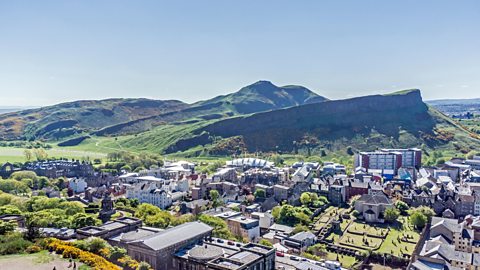
Image caption, Arthur's Seat, Edinburgh
Arthur's Seat in Edinburgh is a volcanic mountain and a popular destination for hill walkers. (John Peter Photography / Alamy Stock Photo)
Image caption, Castle Rock, Edinburgh
Edinburgh Castle was built on top of an ancient volcano. Building a castle up high made it difficult for enemies to attack so castles were often built on natural rocks and cliffs, like volcanic mountains. (Brian Jackson / Alamy Stock Photo)
Image caption, Castle Hill, Stirling
Stirling Castle was built up high on top of a volcanic mountain called Castle Hill. The steep cliffs of Castle Hill gave it a strong defensive position during wars and battles. (Mark Sunderland Photography / Alamy Stock Photo)
Image caption, Glen Coe supervolcano, Highlands
Glen Coe is the site of a supervolcano. A supervolcano is the name of a volcano with massive explosive eruptions. Luckily, it's extinct which means it won't erupt again in the future. (iweta0077 / Alamy Stock Photo)
Image caption, The Black Cuillin, Isle of Skye
The Black Cuillin on the Isle of Skye is a volcanic mountain range. It was formed around 60 million years ago but today it's popular with very adventurous mountain climbers looking for a challenge! (Brian Jannsen / Alamy Stock Photo)
1 of 5
What are the three types of rocks?
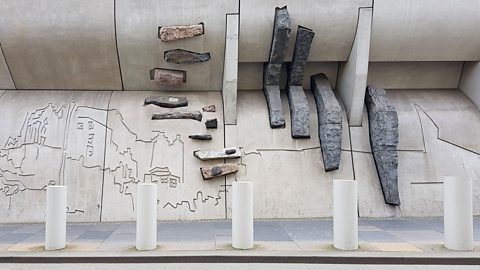
- When lavaMolten rock that reaches the Earth's surface. When molten rock is beneath or within the Earth's crust, it is called magma. erupts on to the Earth's surface and cools down, it solidifies to form igneous rockA rock type formed when magma or lava cool down and solidify. It is very hard and difficult to erode..
- Castle Rock in Edinburgh and Castle Rock in Stirling are both made of a type of igneous rock called dolerite.
The other main rock types are:
- sedimentary rockRock made when sediment, such as sand, mud and pebbles form in layers. Over time, these layers are squashed under more and more layers of sediment. Eventually, the layers turn to sedimentary rock that can be formed in deserts, lakes, rivers and seas.
- metamorphic rockA rock that started out as some other type of rock, but has changed from its original form. For example, rock can change because of high heat or high pressure.

Learn more about different types of rock with Isla and Connor: Rock types

Key words about volcanic mountains and rock
- crust - The outer layer of the Earth. The crust is the solid rock layer upon which we live.
- tectonic plates - Large slabs that fit together to make up the Earth's crust.
- magma - Extremely hot liquid rock below or within the Earth's crust.
- lava - Hot liquid rock when it is above the Earth's surface.
- volcano - An opening in the Earth's crust through which lava, volcanic ash, and gases can escape.
- volcanic eruption - When lava and gas shoot up through a volcanic vent.
- super volcano - A massive volcano that has huge explosive force.
- active volcano - A volcano with a recent history of eruptions that is likely to erupt again.
- extinct volcano - A volcano that is not expected to erupt in the future.
- igneous rock - A very hard rock type that is difficult to erode. It is formed when magma cools under the surface or lava cools above the surface after an eruption.
- sedimentary rock - A soft rock type that erodes easily.
- metamorphic rock - A rock that started out as some other type of rock, but has changed from its original form. For example, it can change because of high heat or high pressure.
- sandstone - A type of sedimentary rock that wears away fairly easily but is easy to carve. This means it is good for building with.
- erosion - Wearing away of materials.
Test your knowledge
Challenge

Design your own castle.
Edinburgh Castle and Stirling Castle were both built on top of ancient volcanoes. The steep cliffs and high rocks of a volcanic mountain made it difficult for enemies to attack and helped the defenders inside look out for attackers.
Research castles to find out what other defensive features castles often had then design your own castle! You could draw, paint or build it.
Here are some ideas to get you started:
- Building up high
- Tall towers
- Battlements
- Arrow slits
- Drawbridges
The steep cliffs on volcanic rock, like Castle Rock in Edinburgh, were used by castle builders to keep people safe from attack.
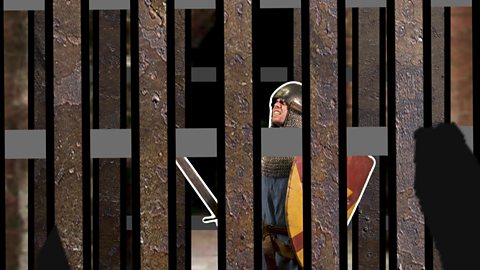
More on Landscapes
Find out more by working through a topic
- count13 of 25

- count14 of 25
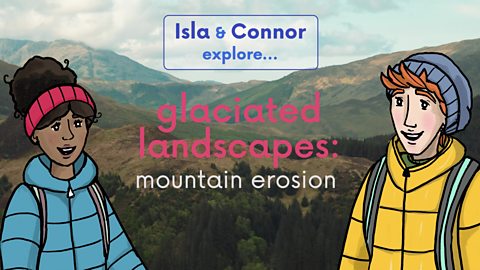
- count15 of 25
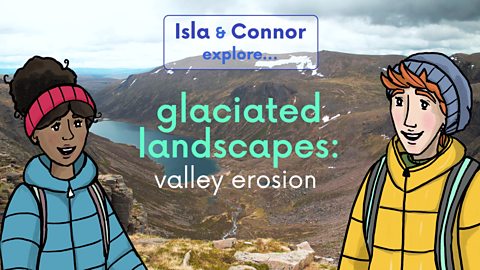
- count16 of 25
